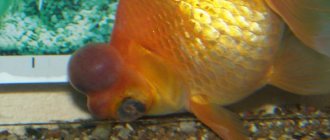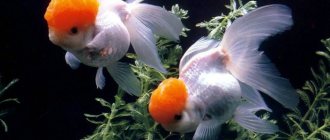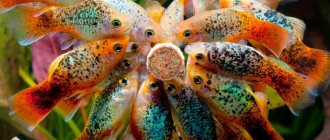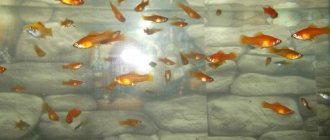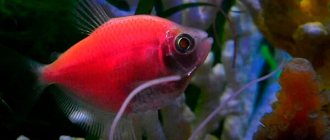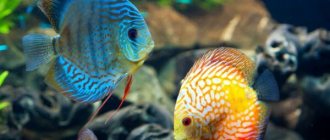Pseudorays are not very widespread in the aquarium hobby among fish owners, but some lovers of exotic pets keep them. Another name for the pseudoray is Seville fish. They are more suitable for catfish lovers because they lead a similar lifestyle. But they are also suitable for beginners, but you will need to find out in advance the features of living in an aquarium.
Initially, the Seville catfish was an exclusively wild representative, living in the mountain rivers of Vietnam, China, Laos and Borneo. Lives only in rivers with strong currents and a high level of water purity. They search for food by tearing sand and scraping from overgrown snags and stones.
Seville pseudorays live for 8 years, but if left uncared for, their lifespan is reduced to 3–5 years.
Appearance
The name pseudoscat immediately describes the external structure - it resembles a miniature copy of stingrays. In general, pseudorays are divided into 3 subspecies, but they are practically indistinguishable and live in identical environmental conditions.
Their bodies are adapted to stick to vertical and horizontal surfaces with the help of sticky suckers, which are located on the fins in the chest and abdomen. The mouth also helps, with which pseudorays eat the surfaces of stones, plants and aquarium glass.
The coloring of the aquarium pseudostingray's body helps it camouflage itself with the dark sand and silt on the bottom. Therefore, their predominant color is brownish-brown, and dark spots and stripes are scattered on the body.
These creatures lack scales, which would protect them from the wounds of opponents and harmful chemicals in the water.
Body size rarely exceeds 7 cm, usually 5 cm.
Origin and description
Sevellia lineolata is native to Asia (Vietnam). It lives in the Huong River (Thua Thien-Hue Province), Tu Bon (Quang Nam), the Tra Cuc and Ve Rivers (Quang Ngai Province) and the En Lao River (Binh Dinh). The color and pattern of fish often depends on the place of origin and may vary, but their basic characteristics are maintained.
Sevellia lineolata is difficult to confuse with other representatives of this genus. Its main distinguishing feature is a series of 3-5 dark stripes on the body, as well as clearly visible stripes on the double caudal fin. It is most similar in appearance to Savellia speciosa (S. speciosa), but has characteristic spots, stripes and color patterns, so it is easy to identify.
Until the mid-90s, Sevellia lineolata remained the only species of this genus, but as the study of the freshwater fauna of Vietnam and Laos revived, other species were discovered, some of which have not yet been described. The first was Sevellia marmorata (C. marmorata), and then 14 more species were described.
Sevellia's body is adapted to life in fast-flowing running water. Its head and body are flattened, and its fins are positioned horizontally. There is a powerful sucking cup (suction cup) that allows the fish to tightly cling to hard surfaces. Sevellia's ability to swim in the water column is noticeably reduced; instead, it can “crawl” along rocks, boulders and other surfaces.
It grows to 5.5 - 6.5 cm in length.
In nature, Sevellia lineolata lives in small, fast-flowing rivers and tributaries with a high oxygen content in the water. The soil of these ponds usually consists of rocks, sand, gravel and boulders. Coastal vegetation is quite diverse, but aquatic plants are usually absent.
The most favorable habitats contain clean, oxygenated water. Combined with plenty of sun, this results in a rich layer of biofilm forming on submerged surfaces.
During the heavy rainy season, some streams may become temporarily very turbid. In one place, in the upper reaches of Thu Bon, this species was found in very fast moving (more than 1 m per second) muddy water. Sevellias have also been found in rock pools not connected to the main river.
Compatibility
Pseudo-rays have high compatibility with most species of inhabitants. Small neighbors without aggressiveness and territoriality will become favorable neighbors.
| Compatible | Incompatible |
| Neons | Astronotus |
| Cardinals | Labeo |
| Botsiya | Tetradon |
| Gourami | Cichlids |
| Guppy | Sumatran barb |
There are also no problems when keeping Seville pseudorays in a group. On the contrary, a flock of 4 or more representatives diversifies the life of the aquarium with movement and fish games.
Reproduction and lifespan
There are many varieties of aquarium catfish. Most of them successfully produce offspring catfish in artificial conditions. The impetus for the beginning of the reproduction process is the combination of certain factors. The presence of roofs is a general condition. A suitable temperature and an influx of fresh water is an impetus for the fish to prepare for spawning.
The female lays up to half a million eggs. The spawning platform is the substrate or leaf of an aquatic plant. Catfish do not show concern for future offspring. Acts of cannibalism are possible. Incubation lasts several days. After which the larvae appear.
There are a lot of species of aquarium catfish, each with its own reproductive characteristics. Amateur aquarists have not mastered the process of obtaining offspring from more than half of the catfish species. Young animals are produced on fish farms, creating special conditions and using hormonal drugs.
Catfish caught in the natural environment are often supplied to the retail trade. Regardless of origin, caution and a high level of adaptability have made many catfish long-lived. No other fish can live as long as aquarium catfish live Large specimens surpass the 30-year mark.
How to determine gender
These fish, similar to stingrays, do not have strong sexual dimorphism, so to determine the sex for selecting a pair, you need to know the distinctive features.
Differences between males and females:
| Difference | Male | Female |
| Coloring | Bright and rich color, especially before the spawning period | Modest, pale color without contrasting elements |
| Size | Smaller body size | They are large in size |
| Body type | More slender and elongated | They are distinguished by their massiveness and wide body, especially in the abdominal area |
Description
Befortia looks extremely unusual and resembles a flounder in its appearance. True, it is much smaller than its double, reaching only 7 - 8 cm in height, and even less in an aquarium. This fish is a member of the loach family, it has a flat stomach, which makes it really look like a flounder, and there is no scaly covering. The body of the fish is light brown, golden in color, covered with dark spots. A dark line also runs along the edges of the fins.
It has fairly wide pectoral fins, which gives its body a pear-shaped shape. The body of the fish is adapted to hold onto the smooth surface of stones in a fast river flow. The pelvic and pectoral fins form a kind of sucker. Having released the water from under the fins and thus creating a vacuum, the fish sticks with its whole body to the smooth surface of the stone or aquarium. The fish has a peaceful character, can swim very quickly, and this is its main protection from predators. But as a rule, large fish are not found in small rapids rivers.
There are slight external differences between females and males. In males, the pectoral fins are located almost at right angles to the body. In females, there is a smoother transition from the contours of the head to the fins. If you look at the fish from above, it will be noticeable that the body of females is more massive than that of males.
Feeding
The diet of Seville pseudorays consists of plant and animal foods. In an aquarium, any food is suitable for them: live, frozen, dried, in the form of granules, flakes and tablets. From live food, it is recommended to feed daphnia, bloodworms, earthworms and tubifex. But an excess of protein food will lead to obesity in Seville pseudorays. Therefore, all leftover food that the pets have not eaten within 4 minutes is removed from the aquarium, and next time when feeding, reduce the dose. Suitable plant foods include lettuce, dandelion, cabbage, cucumbers, and zucchini.
Feed and feeding
The natural diet of Sevellia lineolata mainly consists of benthic algae and the microorganisms living in them, as well as insect larvae.
At home, it is advisable to initially provide aquarium fish with a mature aquarium, with stones and other decorations overgrown with algae. If it is not possible to achieve strong algae growth, or the aquarium has a large number of herbivorous fish that destroy the algae, you may need an additional container with stones to grow additional algae. This nursery does not need to be large, just strong lighting and warm water. The type of algae is also important, with diatoms and green algae being preferred over tough algae such as blackbeard.
Additionally, you can offer products containing spirulina, as well as fresh herbs and vegetables. You can independently prepare food from these products, the binding material in which will be gelatin.
Diseases
The Seville pseudoscat is in good health and, if proper care is observed and the chemical parameters of the water are monitored, it will feel good.
View this post on Instagram
Hooray!!! Seville has sailed! What a funny creature! Hurray!!! Beaufortias out! What a ridiculous creature! #aqua #aquarium #aquariumfish #pleco #catfish #beaufortia #animalcornerromannovikov #aqua #aquarium #aquariumfish #somiti #skat #pseudoskat #freshwaterskat #seville #livecornerromannovikov
A post shared by Roman Novikov ??????? (@romanovikov80) on Feb 1, 2021 at 9:19am PST
Due to the lack of knowledge on breeding and caring for fish, there is still no accurate information about the diseases inherent in Seville fish. But they are susceptible to common diseases that appear upon contact with sick fish or poor conditions in the aquarium: dropsy, external parasites, worms, mycobacteriosis, tumors.
Content
Befortias in natural conditions live in rivers with cold, clean water and fast currents. Therefore, it is necessary to create conditions in the aquarium that are as close to natural as possible. Fish cannot survive without water of high quality, and also saturated with a sufficient amount of oxygen. Using a filter or pump, you can create an imitation of a strong flow of water, which befortia is so accustomed to. However, experts believe that such a measure is needed only for the period of fish adaptation to new conditions. Then the usual flow of water from the filter or without it at all will be enough. The main thing is that the required amount of oxygen is provided, and the water temperature is kept in the range from 18 to 24 degrees.
The bottom should be covered with a mixture of sand and gravel and be sure to add smooth stones and pebbles there, on which the fish will happily graze and gnaw off plaque from them. In addition, the fish needs numerous shelters where it could hide. If the aquarium is not filled with stones, boulders, or driftwood, befortia will hide behind a filter or thermostat. Crawling along the bottom, the fish acquires the same color as the soil or pebbles, thus camouflaging itself.
It is not necessary to plant the bottom with plants, since fish in natural conditions are independent of them. However, to maintain good water quality, you can plant a couple of bushes. It is better if these are different types of ferns or anubias. They will serve as a good shelter for fish, and a biofilm will form on their wide leaves, which is necessary for feeding.
It is advisable to keep befortias in a group of no more than four individuals. For such a number of fish, an aquarium of 50 liters or more is suitable. Since Befortia is a territorial fish, you should not put too many individuals in one aquarium, in order to avoid conflicts and unnecessary stress. But serious collisions usually do not happen. The fish can rush after each other around the aquarium, jostling on the surfaces of the walls, without causing any particular harm to each other. Befortia easily changes its color in a state of excitement, as soon as it sees a rival or food. It becomes a color contrasting with the ground, thereby wanting to declare its superiority. You need to make sure that the lid of the aquarium is tightly closed, as the fish can easily jump out.
Adviсe
- Pisces are easily prone to obesity and have little control over their appetite. Monitor the feed dosage.
- Pseudorays only eat food from the bottom, so buy special food for bottom fish, which quickly settles to the bottom. Also make sure that the fish in the middle layers of the water do not eat all the food.
- Fish are able to tolerate temperature fluctuations only if the water is clean and free of chemical impurities. Therefore, before transporting or moving the aquarium or fish to another place, check the chemical parameters of the water.
Seville fish have not yet been fully studied, and aquarists are just beginning to recognize and introduce them, but this does not reduce their value and beauty. They will help keep the aquarium clean, and their appearance and character will make the tank more lively and interesting to observe.
Previous
FishSchooling fish cherry barb
Next
FishFish is a ball that swells when in danger
Maintenance and care
Keeping these fish is not very difficult, but it is not recommended for beginners to purchase them, especially for a small aquarium. To keep Sevellia lineolata, we recommend an aquarium of at least 75 cm in length and 30 cm in width (volume about 90 liters or more). The water must be clean, highly oxygenated. Therefore, instead of conventional filters with a capacity that passes 3-5 times the volume of water in the aquarium, very powerful aquarium filters are recommended that pass through the volume of water 15-20 times per hour. Such a powerful filter is only the minimum necessary condition; it is additionally recommended to use a mounted power filter (waterfall) and a compressor.
You can use driftwood as decoration in an aquarium, but they must be old, well soaked, and not color the water, which means they do not emit tannins. In addition, coloring the water reduces the effectiveness of artificial lighting, which is an undesirable side effect. The water in the container should be as transparent as possible and transmit light well - this will promote the growth of algae and associated microorganisms.
Also, tasty microorganisms that are useful for catfish often grow on the filter sponge, so some hobbyists use airlift filters in the aquarium so that the sponge is open and always accessible to Sevellias.
Although aquatic plants are rare in the natural habitat of Sevellia lineolata, in an aquarium with catfish you can keep various types of aquarium plants such as Thai fern, Anubias, crinum. Anubias are especially useful because their leaves are prone to algae growth.
Because Sevellia lineolata requires stable water conditions and feeds on microorganisms, it should not be introduced into an immature aquarium that has not undergone a full nitrogen cycle. Also, the aquarium must be covered with a lid, since these catfish can literally climb onto the glass.
Regular partial water changes must be carried out in the aquarium. In this case, all algae should be allowed to grow everywhere, except perhaps the front viewing glass of the aquarium.
Recommended maintenance temperature: 20 – 24 °C. The water temperature can be higher, provided that there is enough oxygen dissolved in the water for the fish. pH : 6.0 – 7.5; Hardness dGH : 1-10°.



